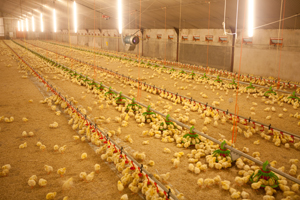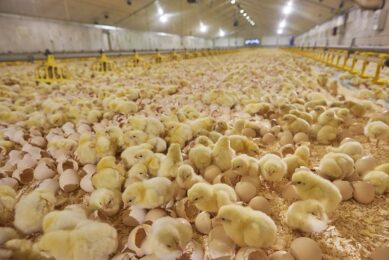Chicks of young breeders demand precise temperature control

Broiler birds only have a short life span. Growing conditions must therefore be optimal from the moment of hatch. This is particularly true for chicks of young breeders. Keeping air and floor temperature in the house fully under control, are essential during brooding.
By Conny Maatjens , HatchTech, the Netherlands
At day of hatch, chicks seems to be anatomically complete. However, next to the development of organs, certain physiological systems require maturation to support further growth and development. Three major systems which are not fully developed at day of hatch are the digestive, immune and thermoregulation systems.
Development and activation of the digestive system is influenced by the intake of feed and water. The intake of feed and water stimulates development of the intestinal tract and an efficient use of nutrient uptake. More efficient use of nutrients leads to a better developed immune system. The development of the thermoregulation system takes place during the first four days after hatch.
Thermal neutral zone
Chicks, which are still poikilotherm (variable body temperature) at the day of hatch, gradually change into a homeotherm (stable body temperature) animal. Before chicks are completely homeotherm, they cannot control their own body temperature. They behave as cold-blooded animals by adjusting their body temperature to the environmental temperature. However, in contradiction to cold-blooded animals, chicks have an optimal rectal temperature.
Chicks, which are still poikilotherm (variable body temperature) at the day of hatch, gradually change into a homeotherm (stable body temperature) animal. Before chicks are completely homeotherm, they cannot control their own body temperature. They behave as cold-blooded animals by adjusting their body temperature to the environmental temperature. However, in contradiction to cold-blooded animals, chicks have an optimal rectal temperature.
The optimal rectal temperature for chicks is between 40 and 40.6°C. When rectal temperatures are in this range, the chick is in its thermal neutral zone. In this thermal neutral zone, the chicks are able to keep their body temperature at a constant level with physical heat regulation without elevating metabolic rate. It is important to maintain chicks in their thermal neutral zone, to ensure early development and growth.
Early brooding period
During the first four days after hatch, the environmental temperature is extremely important to maintain chicks in their thermal neutral zone. These first few days after hatch, is called the early brooding period. Providing optimal brooding conditions does not guarantee an excellent performance, but it is necessary for a good performance in later life. In a normal situation, chicks are transported to the broiler house after hatch. In the broiler house, air and floor temperature are the most important factors to ensure optimal brooding conditions.
During the first four days after hatch, the environmental temperature is extremely important to maintain chicks in their thermal neutral zone. These first few days after hatch, is called the early brooding period. Providing optimal brooding conditions does not guarantee an excellent performance, but it is necessary for a good performance in later life. In a normal situation, chicks are transported to the broiler house after hatch. In the broiler house, air and floor temperature are the most important factors to ensure optimal brooding conditions.
However, the size of a broiler house is very large compared to the size of a day-old chick. Therefore, controlling environmental variables on chick level is very difficult. Failure to meet the requirements on chick level can result in mortality and performance losses. To maintain chicks in their thermal neutral zone, it is important to provide comfort to the chicks. Chick comfort can be reached by providing feed and water and by maintaining rectal temperatures between 40 and 40.6°C. The requirements for chick comfort are for each chick the same, but the environmental temperature that is required to maintain rectal temperatures between 40 and 40.6°C, depends on breeder flock age. To be at the same comfort level, chicks from young breeders require a higher environmental temperature than chicks from prime and old breeders.
Immature thermoregulation system
We define young breeders as being 34 weeks or younger. The chicks that hatch from eggs of young breeders are more sensitive to suboptimal brooding conditions. It is known that chicks from young breeders have an immature thermoregulation system. This means that these chicks require a higher environmental temperature to get in their thermal neutral zone.
We define young breeders as being 34 weeks or younger. The chicks that hatch from eggs of young breeders are more sensitive to suboptimal brooding conditions. It is known that chicks from young breeders have an immature thermoregulation system. This means that these chicks require a higher environmental temperature to get in their thermal neutral zone.
If the higher environmental temperature is not provided, daily growth and development of chicks from young breeders will be lower than the daily growth and development of prime and old breeders. In chicks of prime and old breeders, completion of the thermoregulation system takes four days. However, in chicks of young breeders, the transition towards becoming a fully homeotherm animal can take five to six days.
Two possible reasons
There are two possible reasons for the delay in homeothermy in chicks from young breeders. First, chicks from young breeders are smaller at hatch compared to chicks from prime and old breeders, also they have a larger surface to volume ratio. Therefore, they lose body heat more easily, which in turn may lead to body temperatures below their thermal neutral zone. A second reason is that probably young breeders still need a fair amount of energy for maintenance, growth, and development for their own body.
There are two possible reasons for the delay in homeothermy in chicks from young breeders. First, chicks from young breeders are smaller at hatch compared to chicks from prime and old breeders, also they have a larger surface to volume ratio. Therefore, they lose body heat more easily, which in turn may lead to body temperatures below their thermal neutral zone. A second reason is that probably young breeders still need a fair amount of energy for maintenance, growth, and development for their own body.
The age of the breeder influences the distribution of lipids in the eggs and the use of yolk lipids in the developing embryo. There is evidence that the change from poikilothermy to homeothermy in the chicks from young breeders can be influenced by the lipid composition of the yolk. This could mean that the regulation of heat production during the early brooding period may be different for chicks from young breeders.
Importance of brooding
Because of the two reasons why chicks of young breeders have a delay in homeothermy, the risk of under cooling is more present in the chickens that hatch from eggs from young breeders.
Because of the two reasons why chicks of young breeders have a delay in homeothermy, the risk of under cooling is more present in the chickens that hatch from eggs from young breeders.
Chicks that are being too cold and sit on the floor in the broiler house, will not search for feed and water and have a higher risk to become a victim of several secondary bacterial infections. This may lead to performance losses and a higher mortality rate.
Therefore, make sure that brooding is done well! It is essential to keep the rectal temperatures of chicks of young breeders at the correct level between 40 and 40.6°C. To reach this comfort level, air and floor temperature in broiler houses must be adjusted to reach this optimal level. Correct brooding is extremely important for chicks from young breeders because performance of these chicks can be comparable to chicks that originate from prime breeders when rectal temperatures are maintained between 40 and 40.6°C. Success in meeting the requirements for chicks from young breeders, will lead to an optimal start and further development.
Join 31,000+ subscribers
Subscribe to our newsletter to stay updated about all the need-to-know content in the poultry sector, three times a week. Beheer
Beheer








 WP Admin
WP Admin  Bewerk bericht
Bewerk bericht